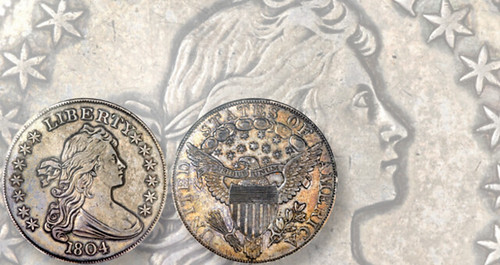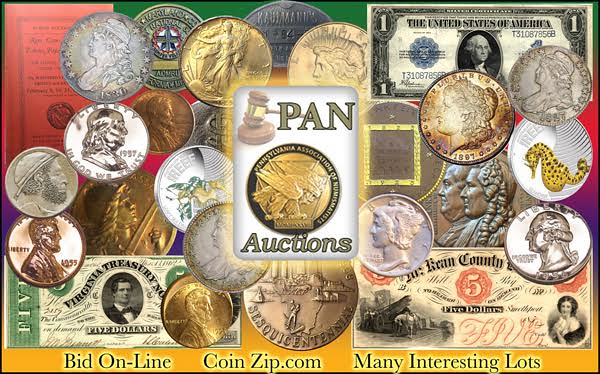
PREV ARTICLE
NEXT ARTICLE
FULL ISSUE
PREV FULL ISSUE
GERALD TEBBEN CONTINUES LOOK AT THE RED BOOK
Gerald Tebben has been writing a series of articles in Coin World about A Guide Book of United States Coins, also known as
the Red Book. Here are excerpts from a couple of the latest segments. -Editor
The Good Samaritan Shilling

The Good Samaritan shilling, a famous 19th century fraud, might be the only coin to be delisted from the R.S. Yeoman's A Guide Book of United States Coins, the Red Book. The “coin” was considered a great rarity in the 1940s and ‘50s. For the first dozen or so editions, the Red Book write-up described the piece: “The Good Samaritan Shilling, supposed to be a pattern piece, was struck at a Boston mint and is extremely rare. This piece is of the same general type as the Pine Tree Shilling, but has a device illustrating the parable of the Good Samaritan on the obverse. It is in silver and dated 1652 on the reverse.” Sylvester S. Crosby, in his groundbreaking 1876 work The Early Coins of America, acknowledged that some doubt the genuineness of the piece, but he was convinced it was a Massachusetts silver pattern. “I am to a considerable extent justified in regarding it as genuine, in the absence of anything like proof to the contrary,” he wrote. In 1959, numismatic researcher Eric P. Newman blew that argument apart, exposing the piece as a fraud. In The Secret of the Good Samaritan Shilling Newman said the Good Samaritan Shilling “was the ‘fakest’ coin in history!” In 1848 the British Museum purchased a Good Samaritan Shilling that was known to exist as early as 1730. The coin, Newman determined, was a Pine Tree Shilling on which the obverse had been ground off and replaced with the seal of the British Commission of Sick and Wounded, a 17th century precursor of the Red Cross. English coin dealer Thomas Snelling and American dealer Thomas Wyatt separately faked their own versions of the supposedly genuine coin and palmed them off on unsuspecting collectors. The Red Book continued to list the piece for a few years after Newman exposed the fraud, but changed the text. “Although this piece was formerly thought to be a pattern for the 1652 shillings, recent findings show that the known specimens are all fabrications.” The King of Coins - the 1804 Dollar

The 1804 dollar has always been a coin of mystery and desire. Was it struck in 1804 or decades later? In 1946, when the first Red Book was printed, both sides had their adherents. The Red Book told the story down the middle, giving both sides of the argument, but offering no conclusion. For the first 15 editions, the Red Book reported, “Those who adhere to the belief that these coins were struck in 1804 point to such evidence as the letter written by Robert Patterson, Director of the Mint, to President Thomas Jefferson. This letter stated that no dollars had been minted ‘during the last two years.’ Inasmuch as the letter was dated April 2, 1807, they infer that dollars were struck during 1804. “Mint records show that 19,570 silver dollars were coined in 1804 and that these coins were struck after March 28, 1804.” The 1804 dollar text concluded, “The 1804 dollar has been and probably will continue to be a subject of much discussion. Unless some new evidence is uncovered the mystery of its existence or disappearance will always be a matter of speculation for the numismatic fraternity” In 1962, Eric P. Newman and Kenneth Bressett, who went on to edit the Red Book, set the record straight with the publication of The Fantastic 1804 Dollar. No 1804-dated dollars were produced before 1834, when the Mint struck display sets of coins for diplomatic missions. Years later, a handful more (Class II) were secretly struck at the Mint for sale to connected collectors. The 1963-dated 16th edition of the Red Book updated the controversy, saying, “Numismatists now know that the 1804 ‘original’ dollars were struck at the mint between 1836 and 1842.” In the years since 1963, the Red Book text has been updated to reflect current research. It now reads, “Numismatists have found that the 1804 original dollars were first struck in the 1834 through 1835 period for use in Presentation proof sets.”
These two examples illustrate the lasting impact of the research and writing of Eric P. Newman. Our numismatic knowledge base today is
vastly improved due to his tireless efforts. The title of his biography is spot-on: Truth Seeker. Thanks, Eric! -Editor
To read the complete articles, see:
To read the earlier E-Sylum article, see:

Wayne Homren, Editor The Numismatic Bibliomania Society is a non-profit organization promoting numismatic literature. See our web site at coinbooks.org. To submit items for publication in The E-Sylum, write to the Editor at this address: whomren@gmail.com To subscribe go to: https://my.binhost.com/lists/listinfo/esylum All Rights Reserved. NBS Home Page Contact the NBS webmaster 
|